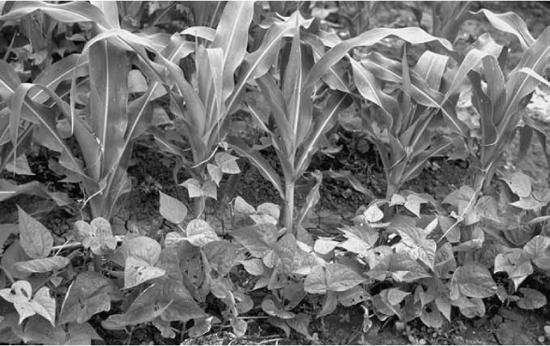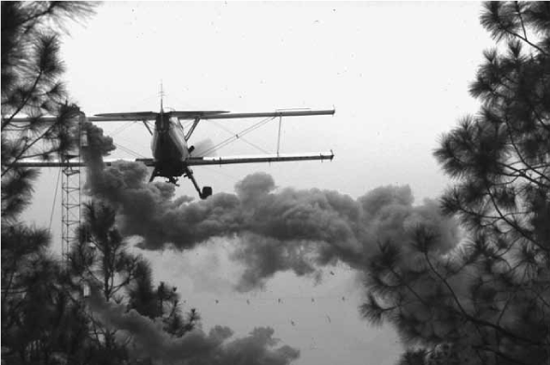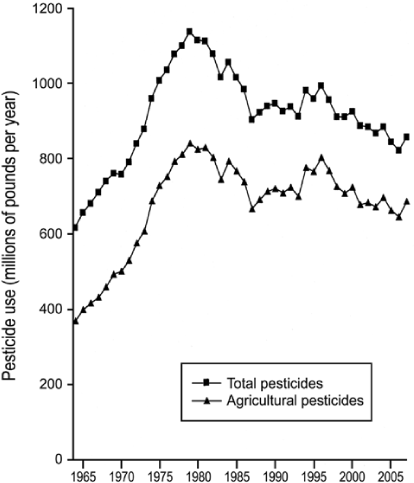The History of the Control of Pests

Chapter 5
The History of the Control of Pests
History
Although we often think that the word “pesticide” is synonymous with the term “chemical pesticide,” the truth is that there are many different ways to control pests and many types of pesticides that are not derived from synthetic chemicals. From a legal perspective, the term “pesticide” is defined as “any substance or mixture of substances intended for preventing, destroying, repelling, or mitigating any pest ….”1 Under this very broad definition of pesticide, not only are the toxic chemicals we normally associate with the term covered, but in addition, many naturally occurring substances and biological organisms themselves can be considered to be pesticides. Moreover, while not fitting within the definition of the term pesticide, a range of agricultural practices can be used to control pest populations.
Scientists believe that chemical pesticides have been used by humans for over 2,000 years. Homer described how Odysseus used burning sulfur as a fumigant to control pests.2 Additional documentation of pesticide use, such as the use of arsenic to kill insects, can be found in literature dating back to the time of Christ. There are records of arsenic being used to control insects dating back to the year 70 AD, when Pliny the Elder recommended its use to kill insects.3 Arsenic was also used as a pesticide as early as sixteenth-century China. Paris Green, a form of arsenic, was employed in the nineteenth century to combat a major outbreak of the Colorado potato beetle.4 The remainder of the twentieth century saw a dramatic increase in the types and quantities of chemical pesticide use.
Early chemical pesticides primarily consisted of metals, such as arsenic, lead and copper, and oils, which rather than exerting a toxic effect, tend to act as physical barriers to pest feeding or actually suffocate the pest. After World War II, vast quantities of synthetic organic compounds, such as DDT, chlordane, parathion, malathion, and a plethora of others were used extensively for agricultural pest control and for public health purposes to control vector-borne diseases such as malaria and yellow fever. During this same period, a number of biological and naturally occurring plant-derived pesticides were also used, although to a much lesser degree. By the end of the twentieth century, genetically modified microorganisms and plants became ubiquitous forms of pest control.
Cultural Controls
Although metals such as arsenic have been used as pesticides for centuries, most pest control up until the early twentieth century was accomplished through non-chemical controls, primarily by means of cultural controls, such as cultivation, sanitation, crop rotation, and sowing and harvesting practices.5 Many pest insects live out at least part of their life cycles in soil, weeds, or accumulated crop debris in farm fields. Plowing the top layer of soil kills many of these pest insects.6 Accordingly, soil tillage historically was a critical component of agricultural pest management. It was not until relatively recently that, as a way to minimize soil erosion, tillage was abandoned in favor of zero or minimum tillage systems, which rely on herbicide usage to control weeds.7 The demise of tillage as a core component of modern agricultural systems has resulted in a dramatic increase in certain soil-dwelling pests.8 Other cultivation pest control techniques used historically include mulching,9 compacting,10 and manuring.11 Sanitation practices are among the most effective pest control practices used in both ancient and modern agriculture.12 By destroying residues of crops left in fields after harvesting, many pest populations that live in such residues are destroyed.13 Related practices such as destruction of weed hosts and selective pruning also serve as effective pest control tools.
Crop rotation, one of the oldest forms of pest control, is very effective for minimizing soil-dwelling pests.14 By alternating the planting of different crops in a particular field, populations of soil-dwelling insects that feed on a particular crop are prevented from building up during periods when their food crop is not present. Thus, when the crop eventually is planted, populations of the pest species generally will not be high enough to cause serious problems. Timing sowing and planting dates to avoid pest outbreaks or to ensure the crop plant is in a resistant growth stage when pest outbreaks are likely to occur, as well as carefully tailoring seed and planting rates and early harvesting also can be effective tools for avoiding pest damage to crops.15 Mechanical compaction of soils and tailored irrigation can be used to manipulate pest habitat by eliminating wet breeding areas or inundating breeding areas.
Perhaps the most important of the cultural controls are sanitary measures to reduce pest habitat.16 For example, an effective way to control disease-carrying mosquitoes is by properly disposing of cans, tires, puddles and any other open container or feature that can collect rainfall and become breeding habitat for mosquito larvae.17 An ambitious effort to eliminate standing water that serves as breeding habitat is credited with eliminating malaria, yellow fever and other insect-borne diseases from regions of Panama, thereby permitting the construction of the Panama Canal. On farms, sanitary methods primarily involve removing crop residues, such as stalks remaining after harvesting, which otherwise become habitat for pests and disease.18
Other non-chemical mechanical means of control include covering crops with mesh material or covering the ground with natural or synthetic mulch to keep out pest insects and weeds. One of the most effective mechanical controls is the use of window screening and mosquito netting to prevent mosquitoes from feeding on humans and thus prevent the transmission of mosquito-borne diseases.19 Cultural controls, including crop rotation, intercropping and sanitation are important components of both integrated pest management programs and organic farming.
Conventional Chemical Pesticides
EPA considers conventional pesticides to be “[a]ny man-made chemical which can be used to kill pests.”20 It was not until the latter half of the twentieth century that the development of synthetic chemical pesticides led to an explosion of global pesticide use. Because these new synthetic chemical pesticides were spectacularly effective at controlling a wide variety of pests, they quickly gained favor and, before long, were ubiquitous. Estimates of global pesticide use are staggering. More than 1,600 types of pesticides are currently available.21 More than 5 billion pounds of pesticides, with a value of almost 40 billion dollars, are used annually around the world.22 Pesticide use in the United States accounts for approximately 22 percent of global pesticide usage, with more than 1 billion pounds of pesticides with a value of approximately 12 billion dollars used annually in the US.23 US exports to other countries exceed 450 million pounds of pesticides per year.24 The use of chemical pesticides has more than doubled since the time large-scale environmental regulation was instituted in the early 1970s. Pesticide use in the US has almost tripled since the time of the publication of Silent Spring in the early 1960s.25 The Pesticide Action Network asserts that, starting in 2004, there was a significant growth in worldwide pesticides sales.26 The current global pesticide market is approximately 40 billion dollars per year.27 This number is expected to grow by approximately 3 percent per year, reaching approximately 52 billion dollars per year by 2014.28 Agricultural pesticides account for approximately 80 percent of the global pesticide market.
The impetus for the dramatic increase in chemical pesticide usage during the very time period that we started to become aware of the serious ecological and health impacts of chemical pesticides is the structure of our farming systems, which rely in large part on vast monocultures. Monocultures eliminate the diversity, and thus the natural forces that can keep pest populations in check, that was formerly derived from intercropping, crop sequencing, or crop rotation. Consequently, large monocultures depend on chemical pesticide inputs to control pests.29
The rapid worldwide adoption of synthetic chemical pesticides began during World War II, with the development of two primary categories of chemical insecticides, the organochlorines and the organophosphates. The first category, the organochlorines, includes the notorious pesticide DDT (the abbreviation for 1, 1, 1-trichloro-2, 2-bis (p-chlorophenyl) ethane),30 developed by the Nobel Prize-winning Swiss scientist Paul Mueller,31 as well as the lesser known chlordane, toxaphene, aldrin, and dieldrin. The organochlorine pesticides were first considered to be highly desirable because, while they are very toxic to a broad range of invertebrates, they are not highly acutely toxic to humans or other mammals. Organochlorine pesticides, such as DDT, are credited with saving thousands of lives from insect-borne diseases, such as typhus and malaria, during World War II.32
Figure 5.1 Total conventional pesticides and agricultural conventional pesticides used in the United States from 1964 to 2007
Source: Timothy Kiely, David Donaldson & Arthur Grube, Pesticide Industry Sales and Usage: 2000 and 2001 Market Estimates US EPA 2004) available at http://www.epa.gov/opp00001/pestsales/01pestsales/market_estimates2001.pdf (last visited October 4, 2012); and Arthur Grube, David Donaldson, Timothy Kiely & La Wu, Pesticide Industry Sales and Usage: 2006 and 2007 Market Estimates US EPA 2004) available at http://www.epa.gov/opp00001/pestsales/07pestsales/market_estimates2007.pdf (last visited October 4, 2012).
The dramatic pest control results initially achieved by the use of DDT and its organochlorine relatives led to such heavy use of these pesticides that large concentrations of the pesticides ended up accumulating in soils and running off into water bodies where non-target fish and wildlife became exposed. Massive amounts of DDT were used in the US in the 1940s, 1950s and 1960s. Worldwide approximately 4 billion pounds of DDT have been used since it was first introduced.33 Moreover, DDT initially was used as a coating of seeds, which were attractive food for birds, further exacerbating the impacts on wildlife. Although DDT did not typically kill birds and other non-target organisms outright, it nevertheless resulted in substantial avian and wildlife impacts. Many of the results were sub-lethal effects on reproduction and behavior, which had long-term impacts on populations.34 Moreover, organochlorine pesticides are extremely persistent in the environment, which makes them highly effective for long-term pest control. However, their persistence in the environment became their downfall when the long-term ecological consequences of these pesticides became apparent. It did not take long for it to become evident that these pesticides accumulated in living tissues and bioconcentrated as they moved through the food chain.35 This resulted in serious impacts to predators at the top of the food chain, including the Bald Eagle and the Osprey. As a consequence, most organochlorine pesticides were either banned or severely restricted, at least in the developed countries of the world.

Photo 5.1 Aerial application of pesticides
Reprinted with permission. Larry R. Barber, USDA Forest Service, Bugwood.org.
The other major category of pesticides that was developed during World War II, the organophosphate pesticides, includes the pesticides parathion, malathion, and chlorpyrifos. Chemicals in this category affect the nervous systems of vertebrates by inhibiting the ability of an important enzyme, called cholinesterase, to regulate properly a neurotransmitter known as acetylcholine, which is critical to proper nerve function.36 Organophosphate pesticides were initially developed as wartime nerve gases.37 Although these pesticides have the environmental advantage of being far less persistent in the environment than organochlorine pesticides, the organophosphates tend to be acutely toxic to humans, other mammals, and birds.38 These pesticides became the pesticides of choice in the United States after most organochlorine pesticides were banned or severely restricted. During the 1990s and early 2000s, EPA brought a number of regulatory actions, in response to actions initiated by environmental organizations or as a result of the stringent registration and reregistration review mandates imposed by the 1996 Food Quality Protection Act, which resulted in the banning or severe restriction of some of the most harmful organophosphate pesticides. In 1980, approximately 228 million pounds of organophosphate pesticides were used in the US.39 By 2007, that number had dropped to approximately 93 million pounds per year.40 Nevertheless, this category of pesticides remains one of the largest categories of chemical insecticide in use in the United States today.41 In addition to posing risks of acute poisoning to farmworkers, these pesticides have been implicated in a large number of avian and wildlife poisonings.
Other categories of chemical pesticides include the synthetic pyrethroids and carbamates. Pyrethrum is a naturally occurring pesticide derived from chrysanthemum flowers.42 Synthetic pyrethroids are synthetically produced versions of pyrethrum. These pesticides have the environmental benefit of having very low mammalian toxicity and low environmental persistence.43 Nevertheless, they are highly toxic to a broad range of invertebrates, including many beneficial insects.44 They are also highly toxic to fish and other aquatic organisms. Carbamates are more persistent than organophosphates in the environment and are generally broad-spectrum, having adverse impacts on many different groups of organisms.45 Other commonly used pesticides are: nematicides, which are not only of high mammalian toxicity and broad-spectrum, but are also very transient in soil; herbicides, which generally are not highly toxic to mammals, but travel easily in water, where they may be toxic to fish and aquatic organisms; and fungicides, which vary greatly in their toxicity.46
Biopesticides
The biopesticides are a category of pesticides derived from animals, plants, and microorganisms. This category includes biochemicals derived from living organisms, macroorganisms biocontrol agents, and naturally occurring microbes. Biopesticides typically are significantly less harmful than most synthetic chemical pesticides primarily because they tend to act through non-toxic mechanisms. In addition, biopesticides tend to narrowly target limited groups of organisms and thus do not affect many non-target organisms. Biopesticides also tend to be used only in very small doses and decompose very quickly. Because biopesticides generally do not act through toxic mechanisms and thereby are of low toxicity, EPA generally requires considerably less data to support a registration for a biopesticide than it would for a conventional synthetic chemical pesticide.
